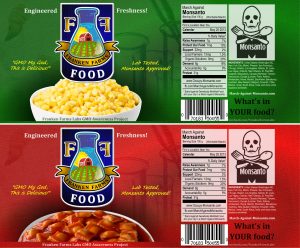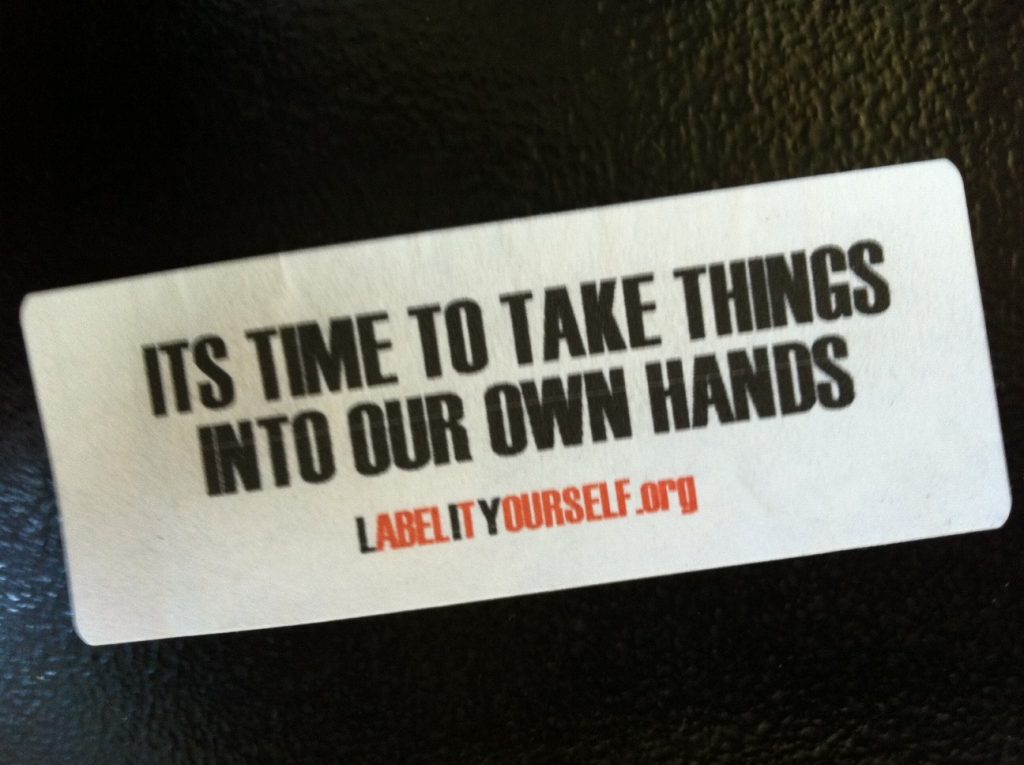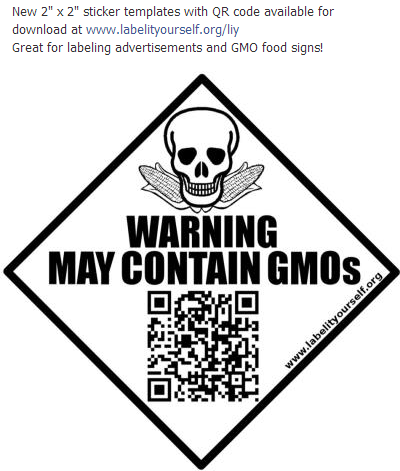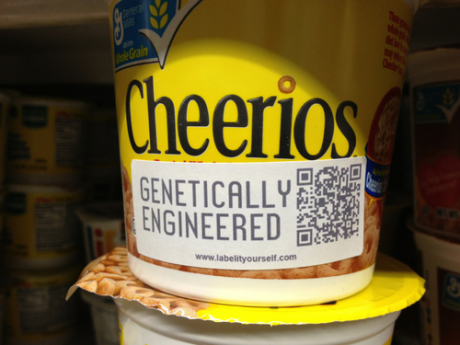“Label It Yourself!” In the last decade, this slogan has mobilized different strands of dissatisfaction with the way food products are identified and their qualities made known (or, more often, unknown) to consumers. Instead of waiting for companies and governments to provide truthful representations of foods and their ingredients, citizens are encouraged to “take things into their own hands,” append new labels to products, and bring to the surface attributes hidden or misrepresented in the standard container.
Like other forms of graffiti, writing on food packages introduces in the ostensibly public but highly controlled environment of the supermarket a surreptitious, clandestine channel of communication between consumers. The food product becomes a vehicle for delivering unsanctioned messages, and the act of perusing the supermarket shelves suddenly acquires a new, suspenseful quality. This sort of informational intrusion cuts, however, both ways: by adding their own interpretations to food packages, consumers interfere with the marketing strategies of food companies, but they also upend efforts to regulate the food system through the official certification of product qualities. The result is a proliferation of writing that makes the market an even more cacophonous and bewildering space than it already is.
Label It Yourself (LIY) activism is often a subterranean affair: most acts of food relabeling go unreported, and to the extent a coherent LIY movement exists, it is made up of decentralized and only loosely coordinated campaigns at the margins of mainstream food reform movements. Yet guerrilla labeling is widespread enough to have prompted the food industry to lobby for its criminalization. In the United States, the Product Packaging Protection Act of 2002 (S. 1223, Sec. 2) amended federal product-tampering legislation and made it a crime to add any writing to a food product prior to its purchase. “Whoever, without the consent of the manufacturer, retailer or distributor, intentionally tampers with a consumer product that is sold in interstate or foreign commerce by knowingly placing or inserting any writing in the consumer product, or in the container for the consumer product, before the sale of the consumer product to any consumer shall be fined under this title, imprisoned not more than 3 years, or both.”
In the congressional hearings that preceded the Act, spokespersons for the food industry denounced a growing tendency to use food products to deliver illicit (“offensive”) messages: pornographic drawings, racist literature, anti-meat brochures, and religious tracts were some of the examples cited before an audience of worried legislators. In the words of the Chief Marketing Counsel for Kraft Foods: “These incidents of tampering amount to product hijacking.” Criminal penalties were necessary, he argued, “to prevent these product tamperers from commandeering a cereal box as their personal soap box.”[1]
***
Currently, the most visible LIY campaign in the United States targets products thought to contain genetically modified organisms (GMOs). Spurred by the refusal of federal authorities to introduce the mandatory identification of genetically modified foods, and further motivated by the defeat of several popular pro-labeling initiatives (most recently Proposition 37 in California and Washington’s Initiative 522), LIY activists have taken it upon themselves to manually tag (Menchini 2013) foods they suspect of containing genetically modified materials.
“Knowing what is in our food and where our food is coming from is our right,” claims a LIY manifesto. “We will label GMOs, we will rescue words like All Natural, Natural Flavors from being hijacked, we will expose unfair practices. If there is nothing to hide then why hide it???!!!! Label It Yourself.”
The movement’s radical DIY approach sets it apart from other contemporary pro-labeling movements. The “Just Label It” campaign (http://justlabelit.org/), for instance, a coalition of several hundred nongovernmental organizations, concentrates its efforts on petitioning the US Food and Drug Administration and Congress in favor of the mandatory labelling of genetically modified foods, but refrains from asking its supporters to carry out the labeling themselves. In contrast, LIY presents itself as “a decentralized, autonomous grassroots campaign to empower people to make educated decisions about what is in their food, without waiting for government or corporations to do it for them.” A handful of websites, Twitter feeds, and Facebook profiles[2] structure a collective debate on LIY tactics, and serve to disseminate labeling templates and photographic evidence of relabeling actions.
***
The issues that bedevil LIY activism and generate the most heated discussion in its online forums are those typical of movements that contest the power of official images: the interrelated questions of the aesthetics of defacement and the ultimate truth value of the iconoclastic gesture.
As the campaign took off in 2012, the most common label used in LIY actions featured a skull with two cornstalks for crossbones, the words “Warning May Contain GMOs,” and a QR code or URL directing the consumer to websites with additional information about genetically modified foods.
This iconography had the merit of highlighting the overt, illicit nature of the relabeling action—it is difficult to mistake the image for an official identifier, and here, as with street graffiti, evidence of trespassing gives the message a particular force—but it also generated a great deal of controversy. It put off sympathizers who would have preferred “more subtle” designs—“ie less SKULLS”, in the words of a visitor to the LIY Facebook page—if only to lessen the chance that, if caught, they would be reported to the police or banned from shopping in the store again.
Indeed, many activists argue that LIY actions should minimize the defacement of the original package and fit as seamlessly as possible within the existing product layout. “I wanna see smaller labels that don’t cover up the existing product info,” a participant in the discussions points out, “if only to be less likely to be pulled by grocers. More subversive.” When another visitor to the LIY Facebook page posted images of products labeled with a small, round, fluorescent sticker containing the words “Warning: may contain GMOs” in clean typeface and no additional image, the design was commended by many for its similarity to official, corporate imagery. “That looks like a real label put by the manufacturer! Well done!”
Over time, the “skull and cornstalks” iconography has given way to more aseptic labels. Currently the favored design is a white rectangle with the words “GENETICALLY ENGINEERED” in large type and no accompanying image. This evolution in label aesthetics towards a certain matter-of-factness has been accompanied by a disambiguation of the message: the noncommittal “may contain” of previous stickers has disappeared in favor of a more assertive declaration of the genetically modified nature of the product.
By dropping the qualifying “may contain,” however, the new label elides a key and perennial point of contention in LIY forums: what sort of epistemic authority legitimizes the marking of a certain product as genetically engineered? How do we know (and to what extent do we need to know) whether a specific product does in fact contain GMOs?
This issue frequently comes up in discussions of products (or retailers) with a particularly green or wholesome image. “I support what you are doing,” writes a visitor to the LIY Facebook page, “because I think this is a great way to use civil disobedience on a grass roots level to get the word out about GMOs, which people are entitled to know about. But PLEASE make sure people are reading before they label—someone put a label on a Silk carton, and not only are they Non-GMO Project certified, it also says: ‘GMOs? No thanks!’ on their cartons, which goes a step further even than getting certified. Clearly, the person who did that has not educated themselves [sic] enough to be putting labels on things.”
These complaints, and the counterarguments that follow, point to the conundrum at the heart of the LIY movement: how can a decentralized movement, predicated on the fact that food manufacturers are withholding relevant information about the origins and composition of their products, legitimize its own acts of identification? The same circumstances that recommend collective action—a situation of structural ignorance sanctioned by the passivity of regulators—are prone to throw the movement into divisive quarrels about the appropriateness of its targets. The dilemma is put succinctly by another visitor to the Facebook discussion, complaining about the (in her mind) unjust tagging of a certain retailer’s products: “I agree that we need truth in labelling, but I’m not comfortable with vandalism.”
Thus, while the “may contain” label struck many as too timid, at least it made room for a degree of uncertainty, or even unknowability, as to the exact nature of the product being tagged. In contrast, the unambiguous and emphatic “GENETICALLY ENGINEERED” would seem to speak with the same force (and font) as a corporate or state-sanction text, but it does so at the expense of eliding questions about the legibility of production systems and supply chains that were at the root of the movement to begin with.
***
“In historical terms,” writes Boris Groys, “the iconoclastic gesture has never functioned as an expression of a skeptical attitude toward the truth of the image.… The desecration of ancient idols is performed only in the name of other, more recent gods.” In his discussion of the artistic “martyrdom of the image”, Groys notes how, “for the time being, commodity brands will remain our latest household gods, at least until some new, nascent iconoclastic anger rises up against them too” (Groys 2008:67–8).
The iconoclasm of the LIY movement is strikingly iconophilic. It operates by adding signifiers to a world of consumption already saturated by images, and thus partakes of the logic of advertising. LIY websites and forums are sometimes little more than visual displays of relabeled products. In fact, the true rite of passage for a would-be activist is the sharing of photographs showing the results of LIY actions. Some go further, and use the marking of genetically modified foods as an opportunity to design and exhibit elaborate, often sarcastic, transgenic counter-iconographies.

Figure 4. Franken Farms LIY Label.
Yet, it is possible to imagine an alternative version of LIY: a form of activism that would operate by subtracting, rather than adding, product identifiers. A movement that, instead of enriching the informational content of the package, would aim to emphasize its opacity, and in so doing reveal the radical inscrutability at the heart of food production and distribution systems.
Such iconophobic tactics would truly unleash the power of LIY activism, which lies in its ability to shatter pretensions of transparency by introducing a moment of surprise and suspicion in the encounter between product and consumer. Who put this label here? What does it mean? How should I act? This is of course an ambivalent power, and the reason why LIY is potentially so disruptive (and irritating) for governments, corporations, and consumers alike. For while it makes a visit to the supermarket a potentially more eventful affair than one would have expected, it also interrupts, at least for a brief moment, the trance-like modes of reading that underlie everyday acts of consumption.



